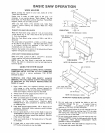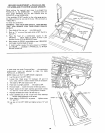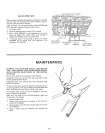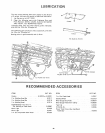
USING THE RIP FENCE
RIPPING, BEVEL RIPPING, RESAWING AND
RABBETING are performed using the RIP FENCE together
with the AUXILIARY FENCE/WORK SUPPORT, PUSH
STICK OR PUSH BLOCK
WARNING: FOR YOUR OWN SAFETY, ALWAYS
OBSERVE THE FOLLOWING SAFETY PRECAUTIONS
IN ADDITION TO THE SAFETY INSTRUCTIONS ON
PAGES 2, 3, and 4.
24
3
4.
Never make these cuts FREEHAND (without using the
rip fence or auxiliary devices when required) because
the blade could bind in the cut and cause a
KICKBACK.
Always lock the rip fence securely when in use.
Remove miter gauge from table.
Make sure blade guard is installed for all thru-sawing
type cuts. Replace the guard iMMEDIATELY following
completion of resawing, rabbeting, dadoing, or molding
operations,,
Frequently check the action of the ANTIKICKBACI<
PAWLS by passing the workpiece alongside of the
spreader while saw is OFF.
Pull the workpiece TOWARD you If the PAWLS do
not DIG into the workpiece and HOLD it, • the pawls
must be SHARPENED,, See "Maintenance" section
5. Have blade extend approximately 1/8 in above top of
workpiece,, Additional blade exposure would increase
the hazard potential.
& Do not stand directly in front of the blade in case of a
KICKBACK, Stand to either side of the blade°
7. Keep your hands clear of the blade and out of the path
of the blade,
& If the blade stalls or stops while cutting. TURN
SWITCH OFF before attempting to free the blade,
9. Do not reach over or behind the blade to pull the
workpiece through the cut oo. to support long or
heavy workpieces , o,. to remove small cut-off pieces of
material or FOR ANY OTHER REASON.
10. Do not pick up small pieces of cut-off material from the
table° REMOVE them by pushing them OFF the table
with a long stick,, Otherwise they could be thrown back
at you by the rear of the blade.
1t Do not remove small pieces of cut-off material that may
become TRAPPED inside the blade guard while the saw
is RUNNING. THIS COULD ENDANGER YOUR
HANDS or cause a KICKBACK.
Turn the saw OFF,, After the blade has stopped turning,
lift the guard and remove the piece°
RIPPING
RIPPING is known as cutting a piece of wood with the
grain, or lengthwise, This is done using the rip fence.
Position the fence to the desired WIDTH OF RIP and lock
in place.
Before starting to rip, be sure
A. Rip Fence is parallel to sawblade.
& Spreader is properly aligned with sawblade
C Antikickback pawls are functioning properly
When ripping LONG BOARDS or LARGE PANELS, always
use a work support
A simple one can be made by clamping a piece of plywood
to a sawhorse.,
BEVEL RIPPING
When bevel ripping materia_ 6 in or narrower, use fence on
the right side of the blade ONLY, This will provide more
space between the fence and the sawblade for use of a push
stick_ If the fence is mounted to the left, the sawblade
guard may interfere with proper use of a push stick,
ALWAYS SUPPORT LONG WORKPIECES
When "WIDTH OF RIP" is 6 in. and WIDER use your
RIGHT Hand to feed the workpiece until it is clear of the
table_
Use LEFT hand ONLY to guide the workpiece .... do not
FEED the workpiece with the left hand.
2O


















